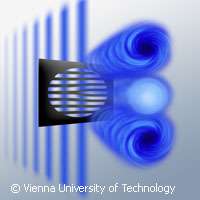Scientists generate rotating electron beams

A team of EU-funded scientists has come up with a way of generating rotating electron beams. The technique, described in the journal Nature, could be used to probe the magnetic properties of materials and could even be applied to manipulate minute particles and set them in motion.
Beams of electrons have been used to study matter for many years - transmission electron microscopes (TEMs) are now commonplace in laboratories worldwide. However, a normal beam of electrons does not provide researchers with information on the magnetic properties of an object. For this a vortex beam of electrons, which rotates in a similar way to the air flow in a tornado, is needed.
Vortex light beams have existed for some time and are used in applications such as micro-motors and 'optical tweezers', allowing scientists to manipulate micrometre-scale particles. A vortex beam of electrons would provide scientists with a tool to manage nanoparticles, but generating such a vortex beam has proven rather difficult.
Earlier this year, a team from Japan succeeded in creating an electron beam with a twist. Their technique entailed producing graphite sheets and then looking for a spot where two or more layers happen to be aligned in such a way that a spiral structure is created. This spiral structure is then able to impart a twist to an electron beam passing through it. In theory, a similar structure could be created artificially, but in practice this is extremely difficult as it requires nanometre-scale machining.
In this latest study, scientists from the University of Antwerp in Belgium and the Technical University of Vienna in Austria took a different approach to the problem. The team created a grid-like 'mask' in a sheet of platinum foil 100 nanometres thick. The mask included transparent and opaque regions that allowed electrons through or blocked them respectively. When an electron beam is directed at the mask, it is diffracted, just as a beam of light is diffracted when it passes through a fine grid. The shape of the grid is carefully designed to turn ordinary electron beams into vortex beams. Crucially, because the grid's dimensions are measured in micrometres rather than nanometres, it is relatively easy to make.
'This technique is a reproducible method of creating vortex electron beams in a conventional electron microscope,' the researchers write. 'We demonstrate how they may be used in electron energy-loss spectroscopy to detect the magnetic state of materials and describe their properties. Our results show that electron vortex beams hold promise for new applications, in particular for analysing and manipulating nanomaterials, and can be easily produced.'
Professor Peter Schattschneider of the Technical University of Vienna is one of the authors of the paper. 'These electron beams could be used in a targeted way to set tiny wheels in motion on a microscopic motor,' he points out. 'Also, the magnetic field of the rotating electrons could be used in the tiniest length scales.' It may ultimately be possible to apply this technology to data transfer (quantum cryptography) and in quantum computers.
More information: Verbeeck, J., et al. (2010) Production and application of electron vortex beams. Nature 467: 301-304. DOI: 10.1038/nature09366
Provided by CORDIS


















